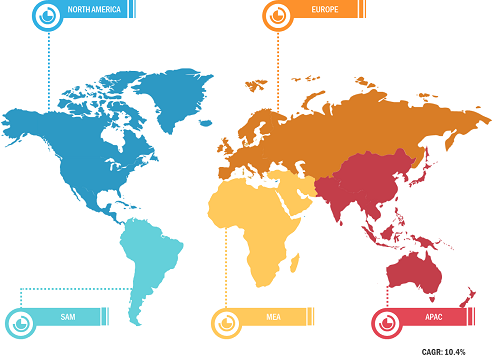Increase in Number of Preterm Births
According to our new research study on "Human Milk Fortifier Market Forecast to 2030 – COVID-19 Impact and Global Analysis – by Form, Distribution Channel, and Geography," the human milk fortifier market size is expected to grow from US$ 274.67 million in 2022 to US$ 566.35 million by 2030; it is estimated to register a CAGR of 9.6% from 2023 to 2030. The report highlights key factors driving the human milk fortifier market growth and prominent players along with their developments in the market.
Human milk fortifiers are nutritional supplements added to human milk to provide additional calories, electrolytes, and vitamins to infants. It is commonly prescribed to preterm babies in the neonatal intensive care unit (NICU) to ensure nutritional intake and improve overall development and growth. In addition, babies with low weight are also prescribed human milk fortifiers. The increasing number of preterm births has surged the demand for human milk fortifiers for the proper growth and development of infants. Many preterm infants need extra nutrients added to their mother's milk. They often need extra protein, calcium, phosphorous, and salt to build strong bones and healthy organs. Human milk fortifiers help provide these extra nutrients to infants. In human milk fortifiers, additional nutrients are added to the milk before it is fed to the babies. Human milk fortifier manufacturers worldwide invest significantly in strategic developments such as product launches, mergers and acquisitions, and business expansion to attract consumers and enhance their market position. For instance, in January 2022, Prolacta Bioscience introduced human milk fortifiers in Japan. The launch was aimed at entering the untapped market in the country and helping improve the health of newborn babies. In November 2020, Lifeblood Milk and the South Australian Health and Medical Research Institute (SAHMRI) entered into collaboration with CSIRO, Australia's national science agency. The partnership aimed to develop human milk fortifiers to improve nutrition and growth in preterm babies.
Global Human Milk Fortifier Market Breakdown – by Region
Human Milk Fortifier Market Forecast to 2030 - Global Analysis by Form (Powder and Liquid), Distribution Channel (Online and Offline), and Geography
Human Milk Fortifier Market Overview and Forecast by 2030
Download Free Sample
The key players operating in the global human milk fortifier market include Abbott Laboratories, NeoLacta Lifesciences Pvt Ltd, Nestle SA, Prolacta Bioscience Inc, Lead Care International Ltd, Raptakos, Brett & Co Ltd, NeoKare Nutrition Ltd, Danone SA, Neolac Inc, and Reckitt Benckiser Group Plc. Players in the global human milk fortifier market focus on providing high-quality products to fulfill customer demand. They also focus on strategies such as investments in research and development activities, new product launches, and expanding production capacities. Key players in the human milk fortifier market are adopting e-commerce platforms to meet the growing demand for nutritional supplements for newborn babies. For instance, in September 2021, Neolacta Lifesciences Pvt. Ltd launched its products, including human milk fortifiers, on e-commerce platforms to ensure easy availability of its products such as Neolacta Human Breast Milk and Neolacta MMF (Mother's Milk Fortifier).
Impact of the COVID-19 Pandemic on Human Milk Fortifier Market
Increasing number of preterm births and rising awareness regarding the benefits of human milk fortifiers were the key factors that boosted the growth of the human milk fortifier market before the COVID-19 pandemic. However, after the onset of the pandemic, market players faced significant challenges due to the supply chain constraints caused by nationwide lockdowns, trade bans, and travel restrictions. During the early phase of the COVID-19 pandemic, implementation of lockdown restrictions and shutdown of manufacturing units led to a production shortfall, creating a demand and supply gap. These factors hampered the profitability of human milk fortifier manufacturers. In 2021, several economies resumed operations as governments of various countries announced relaxations in the previously imposed restrictions. Manufacturers were permitted to operate at full capacity, which helped them overcome the demand–supply gap and other challenges. Further, a significant demand for human milk fortifiers was recorded in neonatal intensive care units (NICUs) and COVID care facilities (for feeding mothers infected with COVID-19).
The report includes the segmentation of the global human milk fortifier market as follows:
The global human milk fortifier market is segmented into form, distribution channel, and geography. Based on form, the human milk fortifier market is segmented into powder and liquid. In terms of distribution channel, the human milk fortifier market is categorized into online and offline. By geography, the global human milk fortifier market is broadly segmented into North America, Europe, Asia Pacific, the Middle East & Africa, and South & Central America. The North America human milk fortifier market is further segmented into the US, Canada, and Mexico. The Europe human milk fortifier market is subsegmented into Germany, France, the UK, Italy, Russia, and the Rest of Europe. The Asia Pacific human milk fortifier market is further segmented into China, India, Japan, Australia, South Korea, and the Rest of Asia Pacific. The Middle East & Africa market is further segmented into South Africa, Saudi Arabia, the UAE, and the Rest of Middle East & Africa. The South & Central America human milk fortifier market is further segmented into Brazil, Argentina, and the Rest of South & Central America.
Contact Us
Phone: +1-646-491-9876
Email Id: sales@theinsightpartners.com